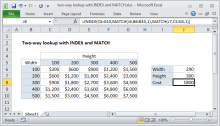First, suppose that bikers arrive to Station 1 (station id =1) according to a nonstationary Poisson process. Complete the below table (enclosed picture file) of arrival rates at Station 1.

- On @RISK for Cost and Schedule Risk using Risk Registers (with example model) @RISK can be used in conjunction with MS Project and Excel to model the schedule and cost risks inherent in large, complex projects. This example demonstrates the use of @RISK to build a complete model of the construction of a new commercial venue.
- RiskAMP is a full-featured Monte Carlo Simulation Engine for Microsoft Excel®. With the RiskAMP Add-in, you can add Risk Analysis to your spreadsheet models quickly, easily, and for a fraction of the price of competing packages. The PERT distribution for cost and project modeling. An easy-to-use wizard for creating tables and charts.
- Learn what value at risk is, what it indicates about a portfolio, and how to calculate the value at risk (VaR) of a portfolio using Microsoft Excel.
Risk analysis software using Monte Carlo simulationfor Microsoft Excel. Trial versions are fully functional for 15 days after installation. No limits on model size or features! No risk or obligation to buy. Access to Palisade’s world-class technical support. Free demonstration relevant to your industry. Risk of hazard = likelihood of occurrence (probability). Severity of harm. We will walk through the steps below to understand the process. Figure 1: How to Use a Risk Matrix. The formula in Cell D13 is given as: =INDEX(C5:G9,MATCH(Severity,B5:B9,0),MATCH(Likelihood,C4:G4,0)) Setting up the Data. We will set up the risk matrix by doing.
Hint: Create a timevalue column. Excel ‘Timevalue (time text)’ returns the decimal number of the time represented by a text string. The decimal number is a value ranging from 0 (zero) to 0.99988426, representing the times from 0:00:00 (12:00:00 AM) to 23:59:59 (11:59:59 P.M.). For example, TIMEVALUE(“1-June-2017 6:35 AM”) = 0.2743. Use the histogram of the timevalue to compute the arrival rates.
Risk Excellence
Second, assign a destination (end station id) to each arrival at Station 1 by using a discrete probability distribution of this form: DISC(p1,1, p2,2,…p12,12)
Determine the value of p1, p2…p12 using the relative frequency bar chart of ‘end station id’. Copy and paste your Excel worksheet.
Finally, build a probabilistic model for the trip duration from Station 1 to Station i, with i=1,2,…12
Risk Excel
i. First step is to remove outliers. If a bike has been rent out for more than 24 hours at a time, it is considered lost or stolen. Remove any trips longer than 24 hours (86,400 seconds). You can also remove more outliers if you think it is necessary.
ii. Considering the scatterplot below (Word document) and the location of the 12 stations, determine the probability distribution of the trip duration from Station 1 to Station i, with i =1, 2,…12.

Risk Excel Add-in
You can use Arena Input Analyzer, @RISK, or any other statistical software you like. You may combine some (or even all) end stations to determine input probability distributions. Copy and paste your Arena Input analyzer results or Excel worksheet.
Risk Excellence Awards

Risk Excel Template
Copy and paste your Excel worksheet.